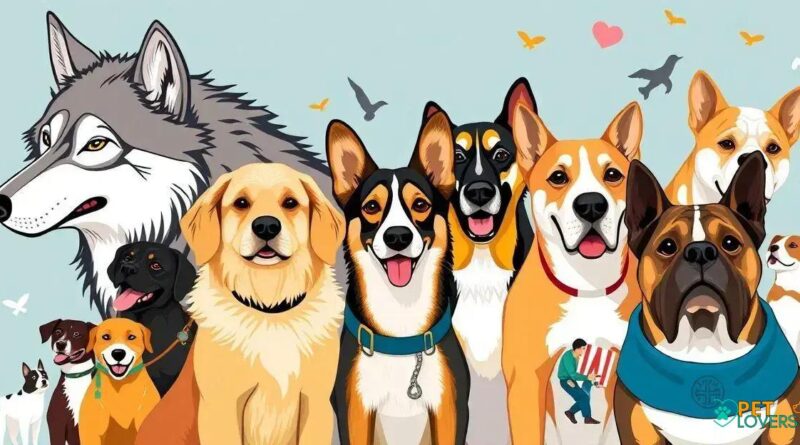What Is a Dog? Unleash the Truth About Man’s Best Friend
Dogs have been domesticated for thousands of years, evolving from wolves into a variety of breeds with distinct traits. They have significantly influenced human history by providing companionship, emotional support, and assistance to individuals with disabilities. With their exceptional senses and ability to communicate, dogs can profoundly impact our lives, showcasing a complex and multifaceted relationship with humans.
Dogs have been a part of human history for thousands of years, with their origins dating back to ancient times.
But what exactly is a dog? Is it a domesticated animal or a wild creature?
In this article, we’ll delve into the fascinating world of dogs, exploring their evolution, behavior, and the special bond they share with humans.
Whether you’re a dog lover or just curious about these amazing animals, you’ll find the answers to your questions and more in this ultimate guide to dogs.
Woof! The Origins of Dogs
Dogs have been domesticated for at least 15,000 years, with some evidence suggesting they may have been domesticated as early as 30,000 years ago. Fossil records show that dogs evolved from wolves, with the earliest known dog fossils found in the Bonn-Oberkassel site in Germany. The exact process of domestication is still debated among scientists, but it is believed that early humans took in wolf pups and raised them as companions or hunting partners, leading to the development of the first domesticated dogs. Over time, these early dogs evolved into the diverse range of breeds we see today.
The evolution of dogs from wild wolves to domesticated animals is a fascinating story. Dogs were initially domesticated for purposes such as hunting, herding, and guarding, but over time they developed into a wide range of breeds with unique characteristics. Today, scientists estimate that there are over 340 breeds of dogs, with new ones being developed all the time. Despite their diversity, all dogs share a common ancestor in the wolf, and their evolution is a testament to the incredible adaptability and flexibility of the canine species.
The relationship between humans and dogs is one of the most enduring and complex in the animal kingdom. On one hand, dogs have been bred for centuries to serve as companions, working animals, and even service animals. They have been known to form strong bonds with their human owners, and many people consider them to be part of the family. On the other hand, some people view dogs as nothing more than pets or even pests. The reality is that dogs are capable of both incredible loyalty and destructive behavior, making them a fascinating and multifaceted species.
Dogs have an incredible range of senses that allow them to perceive the world in ways that humans cannot. Their sense of smell is particularly impressive, with some dogs having up to 300 million olfactory receptors compared to only 6 million in humans. Dogs also have a keen sense of hearing, and can pick up on sounds that are too faint for humans to detect. Their eyesight may not be as sharp as humans, but they are able to see in low light conditions and have a wider field of vision. These incredible senses allow dogs to navigate the world in ways that are both fascinating and impressive.
Dogs have been used as service animals for centuries, assisting people with disabilities and providing emotional support. Today, there are many breeds of dogs that are specifically trained to serve as service animals, including guide dogs, hearing dogs, and mobility assistance dogs. These dogs are trained to perform a wide range of tasks, from opening doors to providing balance support, and are an invaluable resource for people with disabilities. In addition to their practical assistance, service dogs also provide emotional support and companionship, making them an essential part of many people’s lives.
The Evolution of Dogs: From Wild to Domestic
The earliest known dog fossils date back to around 15,000 years ago, found in the Bonn-Oberkassel site in Germany. Since then, dogs have undergone significant changes through the process of domestication. Studies suggest that dogs were initially domesticated from gray wolves, with early humans taking in wolf pups and raising them as companions or hunting partners. Over time, these early dogs evolved into the diverse range of breeds we see today. The exact process of domestication is still debated among scientists, but one thing is certain: dogs have been an integral part of human society for thousands of years.
Dogs: Man’s Best Friend or Frenemy?
Dogs have been described as ‘man’s best friend,’ but is this moniker truly justified? On one hand, dogs have been bred for centuries to serve as companions, working animals, and even service animals. They have been known to form strong bonds with their human owners, and many people consider them to be part of the family. On the other hand, some people view dogs as nothing more than pets or even pests. The reality is that dogs are capable of both incredible loyalty and destructive behavior, making them a fascinating and multifaceted species. Whether you view dogs as friends or frenemies, one thing is certain: they have played a significant role in human history and continue to do so today.
The Amazing Senses of Dogs
Dogs possess a range of senses that allow them to perceive the world in ways that humans cannot. Their sense of smell is particularly impressive, with some dogs having up to 300 million olfactory receptors compared to only 6 million in humans. Dogs also have a keen sense of hearing, and can pick up on sounds that are too faint for humans to detect. Their eyesight may not be as sharp as humans, but they are able to see in low light conditions and have a wider field of vision. Additionally, dogs use their sense of touch to navigate their environment, using their whiskers and paws to gather information about their surroundings.
Dogs as Service Animals: The Incredible Truth
Dogs have been used as service animals for centuries, assisting people with disabilities and providing emotional support. Today, there are many breeds of dogs that are specifically trained to serve as service animals, including guide dogs, hearing dogs, and mobility assistance dogs.
These dogs are trained to perform a wide range of tasks, from opening doors to providing balance support, and are an invaluable resource for people with disabilities. Whether it’s a service dog helping a person with a physical disability or a therapy dog providing comfort to someone with a mental health condition, the impact of these incredible animals cannot be overstated.
Finally, What is the Future of Dogs?
As we’ve explored the origins of dogs, their evolution, their role as companions and service animals, and their incredible senses, it’s clear that dogs have played a significant role in human history and will continue to do so in the future.
From their ability to assist people with disabilities to their capacity to provide comfort and companionship, dogs have the potential to make a profound impact on our lives.
As we look to the future, it’s essential that we continue to learn more about dogs, their behavior, and their needs, and work to improve their lives and well-being.
Whether it’s through advances in training and education, or by providing them with the care and attention they deserve, it’s clear that dogs will remain a vital part of our lives for years to come.
FAQ – Frequently Asked Questions About Dogs
What are the benefits of having a dog as a service animal?
Service dogs are trained to assist individuals with disabilities, providing them with independence and confidence.
How do dogs assist people with disabilities?
Service dogs can perform tasks such as opening doors, picking up items, and providing balance support, helping individuals with disabilities to live more independently.
What are the different types of service dogs?
There are many types of service dogs, including guide dogs for the visually impaired, hearing dogs for the deaf or hard of hearing, and mobility assistance dogs for those with mobility issues.
How do dogs communicate with their handlers?
Dogs communicate with their handlers through body language, vocal cues, and physical touch, allowing them to work together seamlessly.
Can dogs be trained for specific tasks?
Yes, dogs can be trained for specific tasks, such as detecting certain medical conditions, providing emotional support, or assisting with daily activities.
What are the benefits of having a dog as a pet?
Dogs can provide companionship, emotional support, and unconditional love, improving mental and physical health.





